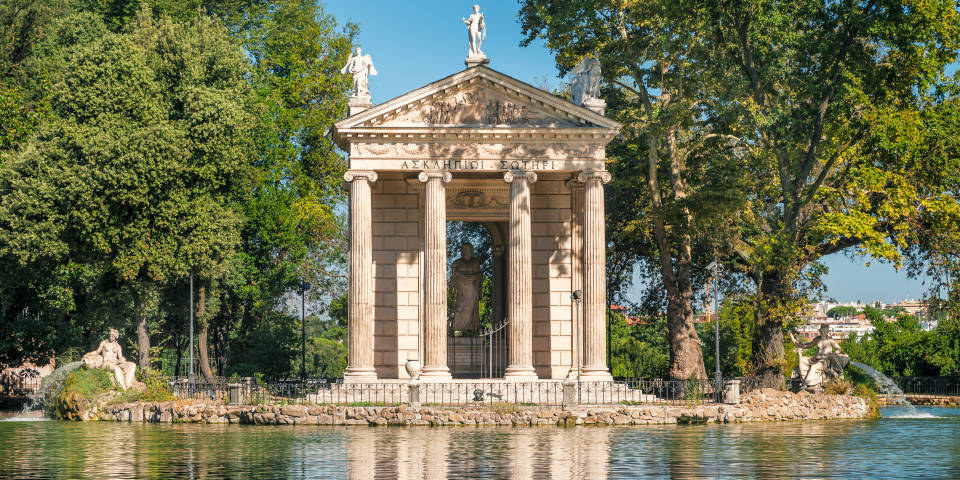

24915 views

| Tip | Villa Borghese is open 24 hours a day for free visits. Plan to visit the Galleria Borghese located on the villa's grounds, the observation deck, and a boat ride on the lake. |
|---|---|
| Recommended tour | |
| Closest bus stops |
|
| Closest subway stations |
|
| Address | Villa Borghese, Rome |
| Website | borghese.gallery/villa-borghese-gardens/ |
Villa Borghese Gardens, the third largest park in Rome, is a treasure trove of picturesque landscapes, romantic settings, and diverse attractions. Nestled within the park’s lush grounds, the renowned Borghese Gallery showcases an impressive collection of art and sculptures, making it a must-see destination for art enthusiasts.
As you stroll through the park, you’ll encounter beautiful sculptures, the Villa Borghese fountain, and the Temple of Asclepius, dedicated to the Greek and Roman god of healing, nestled on a scenic lake. The captivating beauty of the lake makes it a popular spot for couples and newlyweds. Additionally, the park boasts amazing viewing platforms that offer stunning panoramas of Rome, a romantic lake for leisurely boat rides, and a historic water clock that showcases the ingenuity of the past.
In addition to its natural charm, Villa Borghese is home to the Bioparco di Roma (Rome Zoo), a delightful destination for families to discover and learn about a diverse range of animals. The park also features the Hippodrome for races, annual horse shows, and the renowned Globe Theatre, where Shakespeare’s plays come to life. Ideal for dates, wedding photo shoots, and family outings, this exquisite park truly has something for everyone.
Embark on a journey through this enchanting oasis by exploring our ultimate guide to Villa Borghese and its many wonders.
Contents
ToggleWatch a video about the Borghese Gardens on our YouTube:
The Villa Borghese is situated on Pincian Hill, occupying an area of about 80 hectares (148 acres). Earlier, this place was used for gardens and vineyards. The park itself appeared here only in the 17th century under the order of Cardinal Scipione Borghese. The Villa Borghese alleys were decorated with skilfully crafted statues and sculptures. In 1807, many of them were sold to Napoleon.
In the 18th century, the park was redesigned by architect Aspruchchi. At that time, there was a very beautiful artificial lake in the middle of the park. But in the early 19th century, another architect Luigi Canina changed the Villa Borghese again that gave the park an appearance it has today.
In 1903, when there were no direct heirs, the Villa Borghese was transferred to state ownership and was renamed in honor of the King of Italy, Umberto I. However, the new name never became general among the Romans, and the park is still known as it was called originally. In the same year, the first attractions for children appeared there, and 8 years later, in 1911, the existing zoo was opened.
Visiting the observation decks at Villa Borghese during sunrise or sunset provides an unforgettable experience. The soft, warm light bathes the city’s ancient architecture, creating a magical and serene atmosphere. As the sun rises or sets, the hues of the sky shift, painting a mesmerizing backdrop for Rome’s eternal beauty.
From these vantage points, you’ll be treated to stunning views of the majestic St. Peter’s Basilica in Vatican City, standing proudly in the distance. As the sun sets, watch as it slips behind the basilica, casting a warm, golden glow across the skyline – a sight that will leave you in awe.
The Altar of the Fatherland, or Vittoriano, is another impressive landmark visible from the observation decks. This grandiose monument, dedicated to the unification of Italy and its first king, Victor Emmanuel II, adds a sense of history and grandeur to the scene.
The iconic dome of the Pantheon, one of the best-preserved ancient Roman structures, is also clearly visible. It’s architectural splendor and historical significance make it a sight not to be missed.
Opposite Villa Borghese, Gianicolo Hill stands tall, offering another fantastic vantage point to admire Rome’s beauty. Known for its romantic atmosphere and panoramic views, Gianicolo is a popular spot among locals and tourists alike.
Visiting the Bioparco di Roma, the zoo located within Villa Borghese, can be an enjoyable experience, especially for families with children. The zoo is home to over 1,000 animals from around 200 different species, including mammals, birds, reptiles, and amphibians. Some of the animals you can expect to see include giraffes, elephants, tigers, bears, and various primates, among others.
The Bioparco di Roma is dedicated to conservation, education, and research, and it offers a range of interactive experiences, educational programs, and events for visitors of all ages. Families with children can enjoy the opportunity to observe and learn about various animal species, their habitats, and the importance of conservation efforts.
However, it is essential to manage expectations, as the zoo may be smaller and more diverse than some other major zoos worldwide. If you are visiting Rome and have a keen interest in wildlife or are traveling with children, the Bioparco di Roma can be an interesting and educational experience to include in your itinerary.
The price of tickets for the Rome Zoo starts at 13.5 euros and varies depending on the selected date. An open-date ticket is more expensive. If you’re certain of your plans, it’s best to purchase a ticket online several weeks in advance and save money.
Official website: www.bioparco.it/en/home/
Villa Borghese is home to several beautiful fountains, each with its unique charm and artistic value. Although the exact number of fountains in the park may vary, here are two of the most popular and beautiful fountains you can find in Villa Borghese:
These fountains add to the park’s beauty and reflect Rome’s artistic and cultural heritage.
Nestled in the heart of the expansive Villa Borghese Gardens, you’ll find a serene and picturesque spot – the Villa Borghese Lake. This charming oasis provides a perfect escape from the bustling city life of Rome, offering a tranquil setting for relaxation and leisure.
The lake itself is a delightful feature of the park, surrounded by lush greenery and adorned with waterfowl that gracefully glide across the water. At the center of the lake, there’s a small island, home to the enchanting Temple of Aesculapius, an architectural masterpiece that adds a touch of elegance to the landscape. Designed by Antonio Asprucci and completed in 1786, this neoclassical temple is dedicated to Aesculapius, the ancient Greek god of medicine and healing. The temple’s design, featuring Ionic columns and a marble statue of the god, creates a captivating focal point for visitors.
One of the most delightful ways to experience the lake and its surroundings is by renting a rowboat. This provides an opportunity for visitors to leisurely explore the lake and enjoy the stunning views of the temple and park from a unique vantage point. The calm waters and charming scenery make it an ideal activity for couples and families alike. In fact, the romantic atmosphere is perfect for special moments, like a marriage proposal or an anniversary celebration.
So, if you’re looking for a memorable experience while visiting Villa Borghese, consider spending some time at the lake, where you can immerse yourself in the beauty and tranquility of this enchanting Roman gem.
Read also about the Vatican Gardens.
The Orologio ad Acqua del Pincio, or the Pincio Water Clock, is a fascinating and unique attraction that you’ll find near the Pincio Terrace. Constructed in 1867 by the Dominican father and inventor Giovanni Battista Embriaco, this historic water-powered clock is a testament to the ingenuity and creativity of 19th-century engineers.
The clock’s mechanism works by utilizing a constant flow of water, which powers a series of gears and balances. The water is directed through a series of basins and vessels that are carefully calibrated to measure time accurately. As the water fills and empties these vessels, it sets the clock’s hands in motion, allowing it to display the current time.
The Pincio Water Clock is not only an interesting historical artifact but also a beautiful and serene spot. The sound of the flowing water and the surrounding greenery create a peaceful atmosphere, making it a perfect place to relax and reflect while appreciating the ingenious technology of the past.
As you stand near this remarkable timepiece, take a moment to admire its intricate design and consider the skill and knowledge required to create such an innovative mechanism using the simple power of water. It truly is a marvel of engineering and a testament to human ingenuity.
The museum complex in the park’s center is a real gem of the Villa Borghese. It consists of the National Gallery of Modern Art (Italian: Galleria Nazionale d’Arte Moderna), the Borghese Gallery (Italian: Galleria Borghese), and the National Etruscan Museum (Italian: Museo Nazionale Etrusco).
The Galleria Borghese was built by Cardinal Scipione Borghese. At the time of his death, the collection of paintings, sculptures, and other art objects consisted of about 800 exhibits, including the original canvases by Raphael, Caravaggio, Botticelli, Titian, and other brilliant artists of the Italian Renaissance. World-famous is part of the collection with sculptures by Gian Lorenzo Bernini (Davide, Neptune, Apollo and Daphne, etc).
Now, the Galleria Borghese occupies the first and second floors of the villa which is located in the park. Among its exhibits, there are ancient sculptures in good condition, an extensive collection of Roman emperors busts created in the 16th century and canvases of the 15-18th centuries.
Earlier, the Villa Giulia was a papal summer recreation area. Now, it is a large museum dedicated to the culture of the Etruscans, named the National Etruscan Museum. The museum’s collection includes a variety of items of ancient Etruscan art: sarcophagi, statues, jewelry, vases, bronze, and copper items. A ticket to the museum costs 4 euros, opening hours are from 8:30 a.m. till 07:30 p.m. Days off: every Monday, Catholic Christmas on December 25th and New Year on January 1st.
The National Gallery of Modern Art is located in the Villa Borghese gardens, a luxurious building of the early 20th century. Now, it contains more than 5,000 exhibits, among which: are the canvases by Van Gogh, Monet, Degas, Cezanne, and other great masters of painting. The exposition of the gallery covers the 19-20th century.
You can reach the park having climbed another Rome’s landmark – the Spanish Steps. It consists of 138 steps from Piazza di Spagna to an observation deck which offers an amazing view of the area. The Spanish Steps are not the only way to get into the park. The second entrance is at the Porte del Popolo by Piazza del Popolo.
Since the park is very big, it is much better to walk and look for exciting sights using a map.
The International Horse Show at Piazza di Siena is a prestigious equestrian event held within the beautiful grounds of Villa Borghese Gardens in Rome. This significant annual competition, usually taking place around the end of May, attracts top riders, horses, and equestrian enthusiasts worldwide, making it an important event on the global equestrian calendar.
Held in the historic Piazza di Siena, a stunning open space designed in the 18th century, the event offers a unique and charming backdrop for showcasing the skills and talents of the participants.
Featuring various equestrian disciplines such as show jumping, dressage, and eventing, the International Horse Show allows spectators to witness the beauty, power, and grace of these magnificent animals and their riders in action.
Attending the event at Piazza di Siena is an opportunity to enjoy world-class equestrian sports and explore the Villa Borghese Gardens, with its art, culture, and natural beauty. To see the current program and schedule, visit the official website at www.piazzadisiena.it/en/timetable.html and plan your visit to this extraordinary equestrian event.
Author: Artur Jakucewicz
This website uses cookies. For more info read the cookies policy
Rome.us © 2026. Created with love by Roman experts and guides.